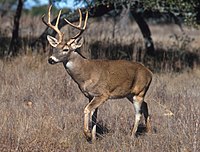
Intensity of red deer browsing on young rowans differs between freshly-felled and standing individuals
Sign Up to like & getrecommendations! Published in 2018 at "Forest Ecology and Management"
DOI: 10.1016/j.foreco.2018.07.048
Abstract: Abstract Because red deer (Cervus elaphus) forage extensively on woody plants, browsing is a serious problem in forest stands especially in initial growth stages. In Slovakia, rowans (Sorbus aucuparia) are the most attractive tree species… read more here.
Keywords: deer; bark; deer browsing; red deer ... See more keywords

The effect of deer browsing and understory light availability on stump mortality and sprout growth capacity in sessile oak
Sign Up to like & getrecommendations! Published in 2018 at "Forest Ecology and Management"
DOI: 10.1016/j.foreco.2018.08.015
Abstract: Abstract Coppice forestry is a conventional silvicultural practice that takes advantage of a tree’s capacity to respond to disturbances by sprouting. Sprouting capacity is determined by many intrinsic and extrinsic factors such as parent tree… read more here.
Keywords: deer browsing; sprout growth; light availability;

Deer browsing and shrub competition set sapling recruitment height and interact with light to shape recruitment niches for temperate forest tree species
Sign Up to like & getrecommendations! Published in 2020 at "Forest Ecology and Management"
DOI: 10.1016/j.foreco.2020.118134
Abstract: Abstract For temperate forests, Michigan, USA, we asked: (1) does evidence exist for a height-dependent sapling recruitment bottleneck caused by shrub layer competition and white-tailed deer (Odocoileus virginianus) browsing and, if so, (2) how do… read more here.
Keywords: deer browsing; recruitment; sapling recruitment; shrub competition ... See more keywords

Deer browsing effects on temperate forest soil nitrogen cycling shift from positive to negative across fertility gradients
Sign Up to like & getrecommendations! Published in 2020 at "Canadian Journal of Forest Research"
DOI: 10.1139/cjfr-2020-0036
Abstract: Herbivores impact soil biogeochemical processes, often increasing nutrient cycling rates under high nutrient availability and decreasing nutrient cycling rates under low nutrient availability. Thes... read more here.
Keywords: deer browsing; browsing effects; temperate forest; forest soil ... See more keywords